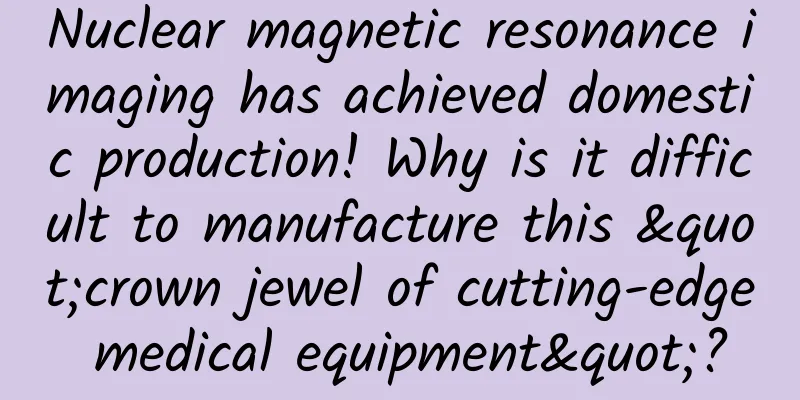Nuclear magnetic resonance imaging has achieved domestic production! Why is it difficult to manufacture this "crown jewel of cutting-edge medical equipment"?

|
We are not unfamiliar with MRI machines, which are often used when we go to the hospital for some examinations and treatments. However, when doing MRI, we not only have to wait in line, but also spend hundreds of yuan, sometimes even more expensive. Isn't it just an instrument inspection? Why is the price so expensive? Many patients and their families often wonder. This is because for a long time, my country did not have the ability to manufacture advanced nuclear magnetic resonance equipment, and such equipment had to be imported from abroad. Importing a better equipment often costs several million or tens of millions of yuan, and this cost is ultimately passed on to the patient. After continuous efforts, my country has made some breakthroughs in the development of nuclear magnetic resonance imaging. Not long ago, my country's independently developed new generation of nuclear magnetic resonance imaging was successful and has entered the mass production stage. This will bring good news to hundreds of millions of patients in my country. So, what is the domestic nuclear magnetic resonance imaging industry like? What benefits will it bring? What does all this mean? Why is it so difficult to build an MRI instrument? The principle of nuclear magnetic resonance technology (NMR) is not complicated. Research has found that the nucleus with an even number of protons and neutrons has a magnetic moment of 0 and cannot produce magnetic resonance; if one of the protons and neutrons is an odd number, then magnetic resonance can occur. Such a nucleus is called a "magnetic nucleus", and the nucleus of the hydrogen element is such a nucleus. We all know that most of the human body is water, and the hydrogen element in the water molecule can meet the resonance conditions. Normally, the hydrogen atoms in the human body are arranged in a disorderly manner. Due to the mutual cancellation of magnetism in various directions, the human body as a whole does not show magnetism. But as long as a strong magnetic field is applied from the outside, the hydrogen atoms will be arranged neatly. This is like a group of people in a square, originally standing in a disorderly manner, with faces facing all directions. But when dancing in the square, as soon as the music starts, a large group of people immediately stand in an orderly manner, with their faces facing the direction of the loudspeaker. In simple terms, the nuclear magnetic resonance instrument uses a strong external magnetic field to make the hydrogen atoms in the human body line up first and then disband. By receiving the electromagnetic wave signals during this period, it can "portray" the inside of the body, and the doctor can judge the condition based on this. ▲The nuclear magnetic resonance instrument is a "powerful instrument" that integrates the research results of multiple disciplines such as physics, materials science, precision machinery manufacturing, electrical automation, image processing and reconstruction, computer science, and biology. The principle is one thing, and turning it into a therapeutic instrument is another. This is because it requires maintaining a high magnetic field and high uniformity in the target area - the higher the resolution of the machine, the larger the magnetic field is required. The MRI machine needs to reach a magnetic field of at least 1.5T (Tesla) to be convenient to use, which is equivalent to 50,000 times the earth's magnetic field. The more advanced 3.0T MRI requires a much stronger magnetic field, and superconducting magnets are needed to solve the problem. Due to the particularity of the magnet design and the complexity of the process, it requires strong comprehensive engineering technology as support, and the technical threshold is very high. Most countries in the world do not have sufficient scientific research capabilities to get involved. At present, the world generally uses strong currents in superconducting coils to generate strong magnetic fields, but this method requires the superconducting magnet to operate at extremely low temperatures (usually below -260°C). In order to reach such low temperature conditions, a liquid helium cooling system needs to be installed inside the MRI machine for continuous operation. In addition, in order to allow superconducting coils and other internal components to operate for a long time below -260°C, the production materials are also a difficult problem, and the improvement of the industrial system and production chain is required to make mass production possible. Other related components such as magnetic signal conversion to image, chips, radio frequency energy reception and release, also involve the application of cutting-edge technology, involving high-precision manufacturing and assembly, requiring superb manufacturing technology levels and strict process and quality control. Therefore, the nuclear magnetic resonance instrument is a "powerful tool" that integrates the research results of multiple disciplines such as physics, materials science, precision machinery manufacturing, electrical automation, image processing and reconstruction, computer science, and biology. For a long time, the technology to manufacture this instrument has only been mastered by a few Western countries, and the market has long been monopolized by giants such as Siemens, GE, and Philips. The "Crown Jewel" of Cutting-Edge Medical Equipment The MRI machine can detect many diseases. The lesions of some diseases such as tumors and heart disease are generally invisible under this "magic mirror". Therefore, it is considered to be the "eagle eye" of many doctors to discover lesions. The magnetic resonance imaging technology (MRI) used by the MRI scanner is another major advancement in medical imaging after CT, and has been used in the medical field since the 1970s. Its advantages include multiple imaging parameters, fast scanning speed, accurate spatial positioning, high tissue resolution, and clearer images, which can help doctors "see" early lesions that are difficult to detect. In addition, this method is non-radioactive, so there is no need to worry about related examinations causing radiation damage to the body. However, due to the high cost of superconducting magnets that make up MRI instruments, the high technical difficulty of spectrometers, radio frequency systems, computer image reconstruction systems, and other factors, as well as factors such as the monopoly of giants, MRI instruments are expensive to purchase and maintain, and are known as the "crown jewel" of cutting-edge medical equipment. In modern medicine, MRI is considered one of the most technologically advanced medical devices, and its accuracy and reliability are widely praised by industry insiders. Compared with other medical devices such as ultrasound and X-ray, MRI can better diagnose diseases. According to the difference in magnetic field, MRI machines are usually divided into two types: 1.5T and 3.0T. Among them, 3.0T can provide a higher magnetic field, allowing doctors to see more detailed and complex images, such as human blood vessels, nerves, subtle bone changes, etc., so it is often used for plain scans, enhanced examinations and angiography of the human body. ▲Scientists have improved the resolution of MRI to 64 million times clearer than before However, my country had no bargaining power for such high-end medical equipment in the past. Not only did it cost a "sky-high" price to import, but the subsequent maintenance and repair costs were also not small. According to industry insiders, it costs 600,000 yuan to replace a part of an MRI device, and no matter what the result, a labor fee of 230,000 yuan is charged. For a long time, the price of nuclear magnetic resonance equipment purchased in my country has been very high. It is reported that a low-end 1.5T device sells for 30 million yuan in China, which leads to a low penetration rate of related equipment in China. The per capita ownership in China is only 8 units per million people, far lower than the 39 units per million people in the United States. Medical diagnosis and medical efficiency are greatly restricted. The Chinese Academy of Sciences and enterprises have finally broken the long-term monopoly of foreign countries The production of advanced domestic MRI machines is directly related to the health and interests of hundreds of millions of people. However, this is a huge challenge for the domestic medical equipment industry, which is still in its development stage. For a long time, Chinese medical equipment companies hardly dared to get involved in this field. After long-term efforts, although we have basically achieved popularization in the 1.5T magnetic resonance imaging level, in the field of 3.0T and high field strength, the core technology is mainly in the hands of foreign brands. After learning from the painful experience, my country made up its mind to research nuclear magnetic resonance technology. In order to break the monopoly of the West, the Chinese Academy of Sciences joined hands with many scientific research institutions, led more than 200 companies and tens of thousands of engineers to work hard for a long time, and finally developed the first 3.0T nuclear magnetic resonance instrument with 100% intellectual property rights in 2015, taking a key step from "0 to 1". In this process, the Shenzhen Institute of Advanced Technology of the Chinese Academy of Sciences worked closely with enterprises, using its strong R&D strength to jointly tackle key problems, and formed more than 100 invention patents in this field. Subsequently, the institute advanced to more advanced nuclear magnetic resonance instruments. At the Shenzhen International High-Performance Medical Equipment Exhibition held not long ago, the world's first 5.0T human whole-body magnetic resonance product was released and became the "star" of the exhibition. This high-end medical equipment condenses the results of the cooperation between the Shenzhen Institute of Advanced Technology of the Chinese Academy of Sciences and other units. It was approved by the National Medical Device Registration (NMPA) in August last year and became the first breakthrough in the world's ultra-high field magnetic resonance imaging universal product. ▲Domestic MRI (Photo source: CCTV report screenshot) It is understood that the image quality of the new generation of MRI machines independently developed by my country is not inferior to that of the internationally advanced MRI equipment manufacturers. This instrument can obtain full-body images of the human body. It not only has higher resolution, but also accelerates the imaging speed. It can even see the dynamic process of human tissue, and the photos will not be "blurred" when the tissue moves. After this type of MRI is widely used in China, it will bring disease examinations using domestically produced equipment in our hospitals to a new level. It will take some time for domestic high-end MRI machines to become popular After my country began mass production of the new generation of MRI machines, they have been welcomed by many domestic hospitals, but their popularization will take some time. First of all, for the research and development of domestic medical devices, solving the "bottleneck" technical problems is the first step, and in the future, stability and reliability must be improved. Only when the instrument has excellent stability and reliability will it eventually be welcomed by the market. At present, due to the small scale of related enterprises in the domestic high-field strength magnetic resonance imaging system industry supply chain, the lack of unified standards for process technology level and quality, and the fact that some key components still need to be imported, it is difficult to form a high-quality market scale advantage, which greatly increases the difficulty of popularizing the domestic magnetic resonance imaging market. In addition, as far as MRI machines are concerned, it is not enough to just sell the equipment. After-sales service, maintenance and repair during the use of the equipment are also very important. In this regard, there is still a big gap between domestic manufacturers and international giants, and this shortcoming needs to be made up as soon as possible. Finally, in the process of promoting domestic high-end nuclear magnetic resonance equipment in my country, it will take some time for some hospitals to change their mindset. For a long time, because my country's medical equipment, especially high-end medical equipment, is backward, it has become a habitual thinking for many hospitals to use imported equipment that is more advanced and reliable. After the relevant instruments in my country have sufficient quality assurance and price advantages, it is a matter of course to promote hospitals to change their mindset. |
>>: The bookmark of the stratum - the "golden nail"
Recommend
2020 Shanxi College Entrance Examination Results Release Time: When to Check College Entrance Examination Results on July 24
On July 20, the Provincial Admissions Examination...
Eating this way really slows down aging! 8 antioxidant foods are not only anti-aging, but also...
From ancient times to the present, people have be...
Jia Zhen, "Little Red Book Merchant Camp No. 6"
Jia Zhen's "Little Red Book Merchant Cam...
Is hair conditioner really a waste of money? If you don't know these points, it's no wonder your hair is falling out!
Expert of this article: Han Hongyu, Associate Chi...
Hearing the Voices of Our Cretaceous Ancestors from Our Middle Ears
Humans can have such sensitive hearing because of...
3 practical methods of user fission growth!
Let me share with you how to achieve fission grow...
Where does the water on Earth come from? my country's latest scientific research results provide new ideas for understanding the evolution of life
Image source: Tuchong Creative There are many dif...
Qingxu Mini Program Production Company, how much does it cost to produce a grain and oil mini program?
Qingxu Grain and Oil Mini Program Production Pric...
Should I take medicine three times a day with my meals? Many people take it wrong...
When we take medicine, we often see "three t...
How to build a product from 0 to 1: Growth
It is not difficult to find growth points for any...
Price inquiry for the production of Qianxinan Shoes and Boots Mini Program. How much does it cost to produce Qianxinan Shoes and Boots Mini Program?
WeChat Mini Program is an application that users ...
Operational case: The growth path behind "Zebra English" monthly revenue exceeding 100 million
What growth paths did Zebra English take to achie...
Serious violations will result in permanent suspension of accounts. WeChat: Further strengthen platform ecological governance
The WeChat team issued an announcement stating th...
iOS 18 hidden feature, supports T9 dialing!
In the first beta version of iOS 18, Apple finall...









